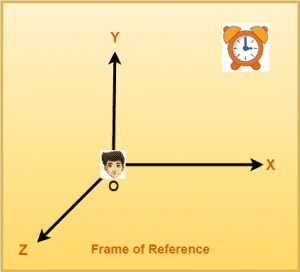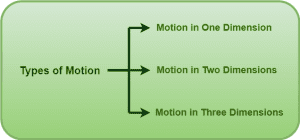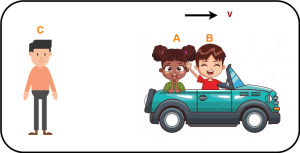Frame of Reference-
| A frame of reference is a frame in which an observer sits and makes observations. |
- A Cartesian coordinate system is attached with the frame of reference.
- A clock is positioned in this system to measure time.
- An observer is always considered to be present at the origin O.

At any given time, the position of a particle is described with the help of its three position coordinates (x, y, z).
Types of Frame of Reference-
There are two types of frame of reference-

1. Inertial Frame of Reference-
- A frame of reference which is either at rest or moving with constant velocity is known as inertial frame of reference.
- Newton’s laws are valid in this frame.
2. Non-Inertial Frame of Reference-
- A frame of reference moving with some acceleration is known as non-inertial frame of reference.
- Newton’s laws are not valid in this frame.
Rest & Motion-
RestA body is said to be at rest if it does not change its position with time with respect to an observer.
MotionA body is said to be in motion if it continually change its position with time with respect to an observer. |
Rest and Motion are relative terms.
Types of Motion-
When a particle moves, its position coordinates change with time. At one time, one or two or all three position coordinates may change.
Accordingly, we have following three types of motion-

- Motion in One Dimension
- Motion in Two Dimensions
- Motion in Three Dimensions
1. Motion in One Dimension-
|
The motion of a particle is said to be in one dimension if only one out of the three coordinates specifying the position of the particle change with time. |
- In such a motion, the particle moves along a straight line.
- One dimensional motion is sometimes known as rectilinear or linear motion.
Examples-
Examples of motion in one dimension are-
- A car moving on a straight road
- A ball thrown vertically up
- A stone dropped into a well
- A ball dropped from a certain height above the ground
2. Motion in Two Dimensions-
|
The motion of a particle is said to be in two dimensions if any two out of the three coordinates specifying the position of the particle change with time. |
- In such a motion, the particle moves in a plane.
Examples-
Examples of motion in two dimensions are-
- Projectile Motion
- Circular Motion
- A carom coin rebounding smoothly from the side of the board
- Motion of a boat in a river
- Motion of an insect on a floor
3. Motion in Three Dimensions-
|
The motion of a particle is said to be in two dimensions if all the three coordinates specifying the position of the particle change with time. |
- In such a motion, the particle moves in a space.
Examples-
Examples of motion in three dimensions are-
- Random motion of a gas molecule
- A kite flying in the sky
- A bird flying in the sky
PRACTICE PROBLEMS BASED ON CONCEPT OF REST & MOTION-
Problem-01:
“Rest and Motion are relative terms.” Justify this statement.
Solution-
- It is rightly mentioned that the rest and motion are relative terms.
- This is because they depend on the observer’s frame of reference.
- A body at rest with respect to one observer might be in motion with respect to another observer.
- A body in motion with respect to one observer might be at rest with respect to another observer.
Consider the following examples-
Example-01:
- A person sitting in a moving train is at rest with respect to fellow passengers.
- While person sitting in a moving train is in motion with respect to a person standing on the platform.
Example-02:
Consider the scenario shown where-
- Two kids A and B are going for a picnic in a car moving forward with velocity v.
- Kid C is sadly standing on the ground.

Here,
- A and B are at rest with respect to each other.
- A and B moves with velocity v in the forward direction with respect to C.
- C moves with velocity v in the backward direction with respect to A and B.
Problem-02:
Is it possible to achieve state of absolute rest or absolute motion?
Solution-
A body at rest with respect to all other bodies is called in state of Absolute rest.
A body moving with respect to all other bodies is called in state of Absolute motion.
Talking about absolute rest,
- It is impossible to achieve the state of absolute rest.
- This is because all heavenly bodies are moving with respect to each other.
Talking about absolute motion,
- It is impossible to achieve the state of absolute motion.
- This is because there exists no reference point which is absolutely fixed in the space.
Read the next article on-
Get more notes and other study material of Motion in One Dimension.

